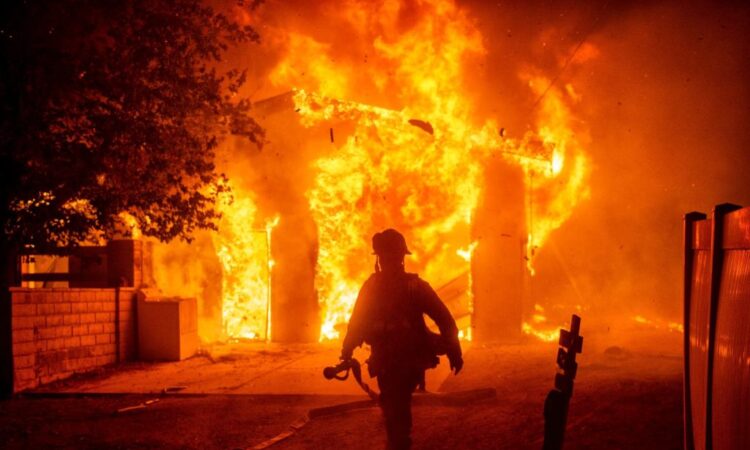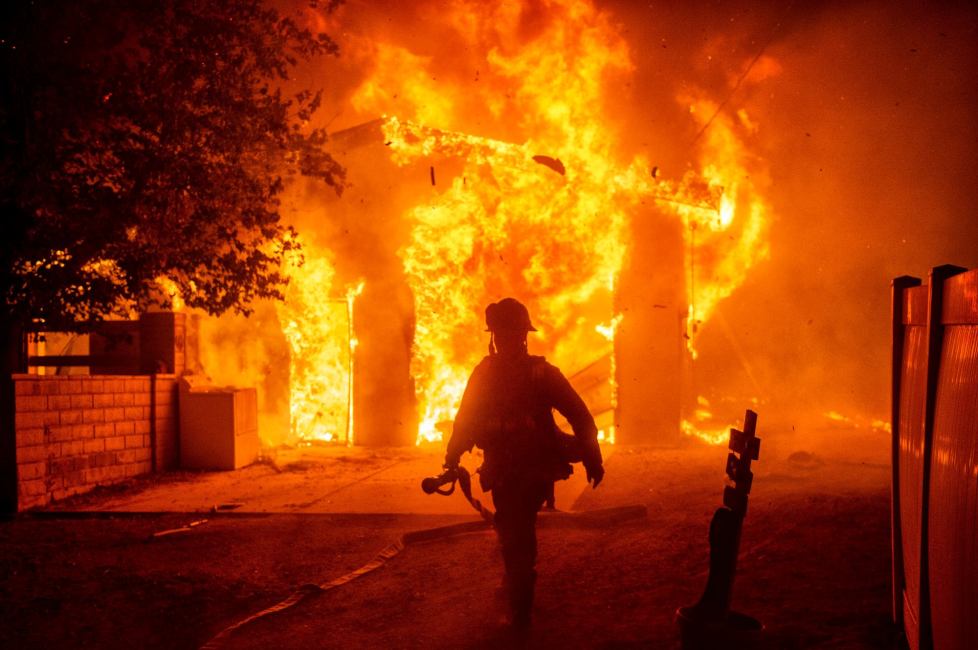One city firefighter made $510,301 … in overtime; who else brought in big extra pay? – Orange County Register


A hinge burns on Baker Canyon at Husk Ave from theTick Fire in Canyon Country in 2019. he use of overtime to fill public safety slots continues to explode in California. (Photo by Hans Gutknecht/MediaNews Group/Los Angeles Daily News via Getty Images)
The Los Angeles city fire captain had regular pay of $169,489 last year, modest as far as these things go.
But he made more than three times that in overtime — $510,301 — raking in total wages of $699,478 and winning the crown for “Most Prolific Overtime Earner Among California’s 327,000+ City Employees, 2022,” according to data from the state controller.
The runner-up was another L.A. city fire captain, with regular pay of $160,892 and a stunning $409,724 in overtime. That’s total wages of $583,585. And neither total includes the $50,000-plus each that the city pays for their health and retirement benefits.
Not so far behind, a Corona fire captain was the most prolific overtime earner among Riverside County’s cities, exceeding $300,000. That was more than double his regular salary.
In Orange County, the top overtime earner was a Fullerton Fire Department battalion chief, clocking more than a quarter-million overtime dollars. In San Bernardino County, an Ontario fire captain fell just shy of a quarter-million overtime dollars to claim the top spot there.
The use of overtime — mostly to fill firefighting and public safety shifts — continues to explode in California, digging deep into the public pocket:
- In 2012, only 213 city workers earned overtime of at least $100,000.
- Last year, 3,680 did. That’s an increase of 1,628%.
- In 2012, 3,814 city workers earned at least $50,000 in overtime.
- Last year, 16,699 did. That’s an increase of 338%.
- In 2012, overtime cost cities $1.3 billion.
- Last year, overtime cost cities $2.96 billion. That’s an increase of 128%.
That California’s top overtime earners are overwhelmingly firefighters might say something about climate change, except that the overwhelming majority of emergency calls are for medical services. Rather, it shines a light on “minimum staffing” requirements — agreed to by city councils and locked in by union contracts — that may be overdue for some adjustment.
More about that in a minute, but — how the heck does a single firefighter rack up more than a half-million dollars in overtime? Does he ever not work? Is that safe for him — and everyone else?
The Los Angeles Fire Department punted, saying this by email: “The best avenue to answer your budgetary inquiry is the City’s Controller’s Office. The Controller is required to exercise general supervision over the accounts of all departments of the City, including the Fire Department. Under the Charter, all City payments must be approved by the City Controller, who is Kenneth Mejia.”
Mejia’s office was much more helpful. Our request for a year’s worth of detailed pay records on the city’s top earners is in progress.
The city controller’s office did point out, however, that the Fire Department makes its own staffing and overtime decisions, not the controller.
County by county
Los Angeles County’s 88 cities spent $1.2 billion on overtime. They had 1,724 workers who made more than $100,000. Most of those worked for L.A. city (1,265).
L.A. County’s list is dominated by Los Angeles City firefighters, as well as L.A. city workers with the infamous Department of Water and Power. One DWP “trouble dispatcher” had regular pay of $55,154 — and made more than six times that in overtime ($357,962).
Load dispatchers and electric trouble dispatchers are critical positions for electric system reliability and public safety, spokesperson Ellen Cheng said.
The former has been historically understaffed and difficult to fill due to the “continuous shift” aspect and the highly stressful nature of the work; these positions are highly specialized and require many years of experience and apprenticeship. Overtime is required to fill vacant shifts, and the city continues to actively recruit for these positions to reduce overtime.
The latter, electric trouble dispatchers, are also on “24/7/365,” and it takes more than 18 months of training to learn the job, Cheng said. Those are the folks who restore power when it goes out and ensure the safety of crews and customers. These positions are also in high demand across the United States, and qualified candidates are in short supply. LADWP continues to actively recruit for these spots as well, she said.
Orange County’s 34 cities spent $152.4 million on overtime, with 154 workers earning $100,000 or more.
The top overtime earner in O.C. cities was the aforementioned Fullerton Fire Department battalion chief, with regular pay of $165,262 and $250,846 in overtime (total wages of $426,503); followed by an Anaheim fire captain with $175,362 in regular pay and $211,504 in overtime (total wages of $408,465).
The 28 cities in Riverside County spent $72.4 million on overtime, with 63 workers earning $100,000 or more.
Their top overtime earner was the aforementioned Corona fire captain, with regular pay of $128,748 and overtime of $312,037 (total wages of $467,595); followed by a Hemet fire captain with regular pay of $88,637 and overtime of $201,582 (total wages of $326,000).
San Bernardino County’s two dozen cities spent $85.5 million in overtime in 2022, and there were 114 workers who made more than $100,000.
Their top-overtime-earning city employee was the aforementioned Ontario fire captain, with $223,300 in regular pay and $245,990 in overtime (total wages $497,201); followed by a Rialto police sergeant with $91,322 in regular pay and $235,582 in overtime (total wages $400,227).
How does this happen?
For years, the answer was simple: It’s cheaper to fill vacant shifts with overtime than to hire new workers. But that’s changing.
Public safety pensions have always been the most expensive. Thousands of firefighters and police officers are still on the old 3%-at-50 formula (which is to say, a 50-year-old firefighter or cop, with 30 years of service, could retire with a pension equal to 90% of his/her annual pay).
But in 2013, pension reforms pushed by then-Gov. Jerry Brown began to change the game.
“The ‘less expensive to fill with overtime’ concept is partially correct,” said Cindy Solis, spokeswoman for the city of Corona, by email.
“This holds true with classic/legacy Public Employees’ Retirement System (PERS) employees who generally fill more senior and skilled positions. However, as the number of employees that were hired after the Public Employees’ Pension Reform Act of 2013 (PEPRA) increases, that ‘less expensive’ premise goes away. The costs become nearly identical for a fully benefited PEPRA firefighter and overtime.”
To illustrate: Emergency workers hired after 2013 have less-generous pension formulas, such as 2.7%-at-57 (our now 57-year-old could retire with 81% of pay after 30 years of service) or 2%-at-50 (our 50-year-old with 30 years in could get 60% of pay), as seen in cities like Anaheim.
“We are seeing a pension reform play out as older formulas phase out and newer, more cost-effective plans become more common,” said Erin Ryan, spokesperson for Anaheim.
“But that is an ongoing transition, and it doesn’t always mean hiring is more cost-effective than overtime. You still have someone working overtime representing one set of pension and other benefits, while hiring means adding an additional person with an entirely new set of benefits.”
Also at play in entertainment-heavy cities like Anaheim and Buena Park — home to Disney, Angel Stadium, Knott’s Berry Farm, Medieval Times — are unique event-related overtime demands, Ryan and Buena Park City Manager Aaron France said.
These venues often request additional security, and reimburse the cities for their troubles. About $150,000 of the roughly $340,000 in total overtime for the three Buena Park officers on the top overtime earners list was “detail pay” reimbursed by Knott’s and Medieval Times, France said.
What else?
The nitty gritty details in the contracts your city council has struck with their firefighter and police unions. The blame for high overtime — or credit for keeping it low — ultimately rests there.
A big variable here is “constant staffing” or “minimum staffing.”
That means a city is required, by contract, to keep a fixed number of firefighters working each and every shift, every hour of the day, every day of the year, regardless of fluctuations in call volume or specific incidents.
Proponents say minimum staffing levels are based on historical incidence data and protect the public as well as firefighters.
Critics say levels are set artificially high to guarantee firefighters juicy overtime and are long overdue for reform.
Many cities and firefighter unions have agreed to reduce staffing levels in recent years, but the cost of overtime clearly suggests more (and/or different) may need to be done. Brows furrow when fire engines appear beside ambulances at medical emergencies.
Other contract variables include how overtime rates are set and who can grab it. Overtime is often paid at higher rates, and access to overtime shifts may be a function of seniority. That means veteran firefighters get first crack, which is likely why the same names pull in the most overtime money year after year.
Corona’s top overtime earner worked 3,867 hours last year, the equivalent of 2.3 full-time employees, due to a combination of all the variables, Solis said. That’s an average of more than 74 hours a week, but firefighters work in 24-hour shifts.
General chaos
California is prone to wildfires, floods, landslides and natural other disasters that require firefighters to be readily available for emergency responses, leading to increased overtime, city officials said.
And there’s the matter of helping neighbors in need. “The overtime costs associated with the City of Orange stem from the City’s commitment to uphold the California Office of Emergency Services’ mission to protect California lives and property,’ said Jack Morgan, senior assistant to the city manager.
Orange and other cities participate with the state’s emergency strike teams, sending local personnel to large-scale wildfires wherever they may be. It’s an investment — we’ll likely need help when it’s our turn for natural disasters — that often results in higher overtime costs. Those, at least, are reimbursed by the state and federal governments, but in the end, it’s all your money, people.
Also: Emergency workers get paid for being on-call and for specialized certifications or skills. When workers are sick, injured or on vacation, those shifts need to be filled.
“Newport Beach’s FY 2022 fire department overtime was driven primarily by three factors: vacancies, mutual aid deployments, and training of new firefighter/paramedics,” said spokesman John Pope. “Newport Beach received more than $1.1 million in state reimbursements directly for firefighter overtime.
Vacancies are an issue everywhere. Brea used overtime to fill some 10 firefighter vacancies last year, said city spokesperson Liz Pharis. Another four firefighters were in paramedic school, which takes eight months to complete. Recruiting a firefighter is an eight-to-nine-month process from job posting to hiring date, and the Brea Fire Department has eight recruits finishing an internal academy. They will soon be placed on shifts to ease the use of overtime.
On the policing side of the ledger, recruitment has been challenging for cities all over the nation in the wake of George Floyd’s killing. Buena Park is still recruiting police officers, and “while we have made significant progress, we are still a few short of our 95 sworn complement of officers,” France said.
Brace yourselves for the future.
“Anaheim Fire & Rescue responds to just about every type of call imaginable, including earthquakes or other major disasters, mass causality traffic accidents, hazardous materials incidents, search and rescue, confined space rescues, and, recently, pandemic response,” Ryan said. “In the years ahead, we will look to our firefighters to play a critical role preparing for and responding to climate events and other emerging challenges.”






